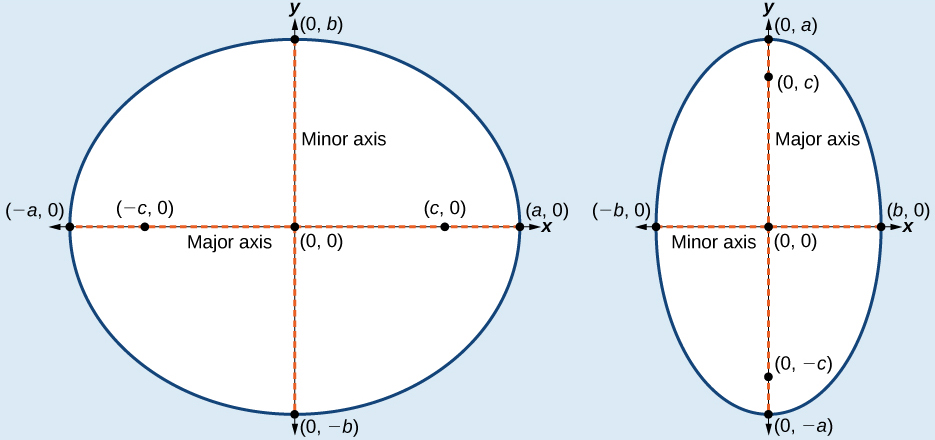| << Chapter < Page | Chapter >> Page > |
The standard form of the equation of an ellipse with center (0,0) and major axis on the x-axis is
where
The standard form of the equation of an ellipse with center (0,0) and major axis on the y-axis is
where
Note that the vertices, co-vertices, and foci are related by the equation c2=a2−b2. When we are given the coordinates of the foci and vertices of an ellipse, we can use this relationship to find the equation of the ellipse in standard form.

Given the vertices and foci of an ellipse centered at the origin, write its equation in standard form.
What is the standard form equation of the ellipse that has vertices (±8,0) and foci (±5,0)?
The foci are on the x -axis, so the major axis is the x -axis. Thus, the equation will have the form
The vertices are (±8,0), so a=8 and a2=64.
The foci are (±5,0), so c=5 and c2=25.
We know that the vertices and foci are related by the equation c2=a2−b2. Solving for b2, we have:
Now we need only substitute a2=64 and b2=39 into the standard form of the equation. The equation of the ellipse is x264+y239=1.
What is the standard form equation of the ellipse that has vertices (0,±4) and foci (0,±√15)?
x2+y216=1
Can we write the equation of an ellipse centered at the origin given coordinates of just one focus and vertex?
Yes. Ellipses are symmetrical, so the coordinates of the vertices of an ellipse centered around the origin will always have the form (±a,0) or (0, ±a). Similarly, the coordinates of the foci will always have the form (±c,0) or (0, ±c). Knowing this, we can use a and c from the given points, along with the equation c2=a2−b2, to find b2.
Like the graphs of other equations, the graph of an ellipse can be translated. If an ellipse is translated h units horizontally and k units vertically, the center of the ellipse will be (h,k). This translation results in the standard form of the equation we saw previously, with x replaced by (x−h) and y replaced by (y−k).

Notification Switch
Would you like to follow the 'Algebra and trigonometry' conversation and receive update notifications?